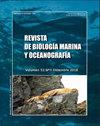监测极度濒危海鸟的发生和威胁的新兴平台:智利和东南太平洋的挥手信天翁
IF 0.5
4区 生物学
Q4 MARINE & FRESHWATER BIOLOGY
引用次数: 1
摘要
西班牙长寿海鸟物种,如信天翁和海燕,广泛分布在海洋中,种群较少,在渔业中的副渔获物是对其保护的主要威胁之一。其中,在东南太平洋沿岸传统分布以外的国家的专属经济区(专属经济区)中,很少发现伊罗拉塔石斑鱼信天翁。本文收集了20世纪80年代以来从旅游活动(即鸟类毛皮观察)等海上非系统观测中获得的加拉帕戈斯信天翁的现场分布记录。反过来,在智利北部和中南部(东南太平洋)之间作业的延绳钓和拖网渔业中纳入了系统监测的记录。根据与这些相关的环境特征,如生殖期的存在/不存在和厄尔尼诺事件的指标,如南方振荡指数(IOS)的负值等,分析了目击事件的发生情况。共有13次目击加拉帕戈斯信天翁,其中76.9%在繁殖期(12月至4月)以外。记录显示,加拉帕戈斯信天翁向南分布到智利中南部(38°S),在加拉帕戈斯群岛以南4391公里,在南美洲海岸以西920公里(79°W)。加拉帕戈斯信天翁是与工业延绳钓和底栖拖网渔业合作登记的。没有副渔获物记录,尽管观察到与这些渔业的船只有关的个体以丢弃和内脏为食,这表明该物种可能面临死亡风险。53.8%的目击事件发生在南方振荡指数(IOS)的阳性读数期间,代表比厄尔尼诺南方振荡中性值(eNOS)更冷的条件。信天翁和海燕等英国长寿命海鸟物种在海上广泛分布,种群较少,在全球范围内受到渔业捕杀的威胁。其中,在东南太平洋传统分布以外的国家专属经济区(EEZS)中,很少发现伊罗拉塔信天翁。在这篇文章中,汇编了从非系统(远洋观鸟)和系统(渔业监测)记录中获得的关于信天翁的现场分布记录。观察的发生是为了记录存在/不存在繁殖期和厄尔尼诺现象等特征,如南方振荡指数等。共有13次对波信天翁的观察被描述,其中76.9%的观察与非繁殖期(12月至4月)有关。记录显示,波浪信天翁到达加拉帕戈斯群岛以南4391公里(38°S)和南美海岸以西920公里(79°W)。波浪信天翁与工业远洋长线和底栖拖网渔业有关,尽管没有ByCatch的记录,但对个体进食的观察表明,这一物种可能面临死亡风险。53.8%的视线是在南方振荡指数(SOI)的正读数期间,这代表了比中性厄尔尼诺-南方振荡(ENSO)更冷的条件。本文章由计算机程序翻译,如有差异,请以英文原文为准。
Emerging platforms to monitor the occurrence and threats to critically endangered seabirds: The waved albatross in Chile and the Southeast Pacific
espanolLas especies de aves marinas longevas, tales como albatros y petreles ampliamente distribuidos en el mar y con poblaciones reducidas, tienen a la captura incidental en pesquerias como una de las principales amenazas para su conservacion. Entre estas, el albatros de Galapagos Phoebastria irrorata es escasamente detectado en las Zonas Economicas Exclusivas (ZEE) de paises mas alla de su distribucion tradicional a lo largo del Pacifico Sudeste. En este articulo se recopilan registros distribucionales del albatros de Galapagos in situ y obtenidos desde observaciones no sistematicas en el mar, tales como actividades de turismo (i.e., observacion pelagica de aves) desde la decada de 1980s en adelante. A su vez, se incorporan registros desde monitoreos sistematicos en pesquerias de palangre y arrastre, operando entre el norte y centro-sur de Chile (Pacifico Sudeste). La ocurrencia de avistamientos fue analizada segun caracteristicas ambientales relacionadas a estos, como presencia/ausencia de periodo reproductivo e indicadores de eventos El Nino, tal como valores negativos en el Indice de Oscilacion Sur (IOS), entre otros. Se describio un total de 13 avistamientos del albatros de Galapagos y con 76,9% de estos fuera de su periodo reproductivo (diciembre a abril). Los registros evidencian una distribucion meridional del albatros de Galapagos hasta el centro-sur de Chile (38°S), alcanzando 4.391 km al sur de Islas Galapagos, asi como hasta 920 km al oeste (79°O) desde la costa Sudamericana. El albatros de Galapagos fue registrado en asociacion con pesquerias industriales de palangre pelagico y arrastre demersal. No hubo registros de captura incidental, aunque la observacion de individuos asociados a barcos de estas pesquerias para alimentarse de descartes y eviscerados sugiere un potencial riesgo de mortalidad para esta especie. El 53,8% de los avistamientos fueron durante lecturas positivas del Indice de Oscilacion Sur (IOS), representando condiciones mas frias que las neutrales de El Nino Oscilacion Sur (ENOS). EnglishLong-lived seabird species such as albatrosses and petrels, which are widely distributed at sea and have small populations are threatened globally by bycatch in fisheries. Among these, the waved albatross Phoebastria irrorata is scarcely detected in the Exclusive Economic Zones (EEZs) of countries beyond its traditional distribution throughout the Southeast Pacific. In this article, in situ distributional records on the waved albatross obtained from non-systematic (pelagic birdwatching) and systematic (fishery monitoring) records were compiled. Occurrence of sightings was carried out in relation to recording traits as presence/absence of breeding period and El Nino proxies such as the Southern Oscillation Index (SOI), among others. A total of 13 sightings of waved albatrosses was described which 76.9% of sightings were related to non-breeding period (December to April). Records indicated waved albatrosses reached 4,391 km south of the Galapagos Islands (38°S) and 920 km west of the South American coast (79°W). The waved albatross was associated with industrial pelagic longline and demersal trawl fisheries, and although there were no records of bycatch, the observation of individuals feeding on discards and offal suggests a potential risk of mortality for this species. 53.8% of sightings were during positive readings of the Southern Oscillation Index (SOI), representing colder conditions than neutral El Nino Southern Oscillation (ENSO).
求助全文
通过发布文献求助,成功后即可免费获取论文全文。
去求助
来源期刊
CiteScore
0.70
自引率
0.00%
发文量
41
审稿时长
12 months
期刊介绍:
Publicar desde una perspectiva científica, artículos originales, decididos por un proceso de revisión por pares, invitando a expertos de reconocido prestigio en el área. Los trabajos publicados se caracterizarán por su solidez teórica-metodológica, actualidad y relevancia para las ciencias marinas.
Se reciben trabajos inéditos derivados de la investigación científica realizada en ambientes marinos y estuarios, en formato de Revisión, Artículos, Notas Científicas, y Obituarios en las siguientes disciplinas::
Biología-Ecología marina
Oceanografía física, química y biológica
Contaminación marina
Geología marina
Sistemática, Faunística y Biogeografía Marina
Manejo Costero
Acuicultura marina
Pesquería marina.

 求助内容:
求助内容: 应助结果提醒方式:
应助结果提醒方式:


